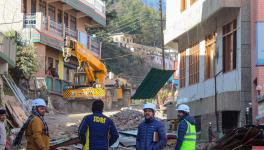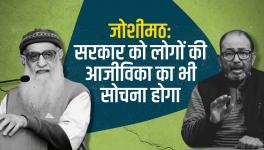The Sinking of Joshimath: An Administrative Enquiry

Image credit: The Leaflet
What are the raging protests in Joshimath about?
Joshimath, the gateway to Badrinath in Uttarakhand, is undergoing a climate crisis. Well over 850 houses in the hilly town have developed cracks in the last month.
Residents blame the construction works going on for the Tapovan Vishnugad hydel project under the aegis of the National Thermal Power Corporation (NTPC). The project involves construction of a tunnel underground, which the NTPC claims does not pass from under Joshimath. However, the residents have asserted that the aquifer burst caused due to the same tunnel has led to drying of water sources, which has further caused subsidence. Joshimath has now been declared “a land subsidence zone” and thus, unsafe for living.
The project has been mired in climate controversies since its inception, with the NTPC halting it from time to time to resolve the contentions. The government is evacuating residents, while some, along with activists, continue to protest against the hydel project.
A petition was filed in the Supreme Court for the declaration of the Joshimath crisis as a national disaster, which was dismissed last month on the grounds that similar petitions concerning the hydel project are being adjudicated by the Uttarakhand High Court. The high court had in 2021 dismissed a petition filed after the glacial floods in the region, seeking to restrain the project till frequent local instances of landslides, subsidence, and cracks were declared as national disaster. The high court had further called the petition highly motivated and at the behest of an unknown entity.
The history of this town with respect to land subsidence has been scrutinised in the past by a 1976 committee formed by the then Union government. The committee, led by the then Garhwal Commissioner M.C. Mishra, concluded that the topography of Joshimath was unsuitable for construction and development of a township.
In 2021, after the glacial floods, the government emphasised on its 2018 notification issued by the Union Ministry of Water Resources, River Development and Ganga Rejuvenation, wherein the quantum of water flow into Ganga was fixed. However, the Union Ministry of Power, along with the government of Uttarakhand, resisted this on the basis that their revenue from hydel projects would fall excessively if the water flow into the river is increased, irrespective of the ecological imbalance that would ensue. Yet, the government evidently went ahead with the construction of this project.
This is not the sole suspect project in Joshimath approved by the executive and the judiciary. The 900-km Char Dham Mahamarg Vikas Pariyojna, a highway project, was exempted from environmental impact assessment (EIA) clearance on the grounds that it has been divided into segments of less than 100 km and is of strategic importance for the army. The Supreme Court did not interfere once the administration termed it as a defence policy decision, thus letting the administration bypass the environmental security aspect. Eventually, an assessment was undertaken for an already approved project.
Is there a legal basis for the residents’ concerns?
The Environment Protection Act, 1986, under which the Environmental Impact Assessment notification of 2006 has been formulated, requires such above-mentioned projects to be scrutinised for environmental impact on the surroundings. The Act in itself does not mention the hydroelectric mode of power generation, nor do the Environment (Protection) Rules, 1986. However, the 2006 notification explicitly mentions the same and empowers the Union government to constitute an expert appraisal committee, on the recommendations of which it shall provide clearance to the projects.
The hydel project was granted environmental clearance in 2005 under the then EIA Notification, 1994. Thereafter, multiple instances of landslides and cracks in Joshimath occurred, inviting expert bodies with conflicting reports regarding the impact of the hydel project on the ecology of the area, with some reports concluding that the project is at a safe distance from the town while others saying that its long-term impact is beginning to show. The highway project was in fact subjected to an EIA after it was approved, instead of as a precautionary preventive step that the notification provides for.
What would an administrative enquiry into the fiasco look like?
This article aims to analyse whether administrative law exists legitimately in the context of environmental clearances, and whether it ensures accountability for governance decisions to citizens. In furtherance of this, French philosopher Jacques Derrida’s deconstruction will be employed to break down the steps into smaller enquiries to reach multiple aspects of the initial question.
First, is administrative law in itself lawful?
American legal scholar Professor Phillip Hamburger answered this question in the negative because according to him, administrative law is merely a tool for the government to do as it pleases. He traced the history of administrative actions since medieval times to modern society to conclude that they propagate absolutism at the hands of the government in the name of filling gaps in laws. It is assumed by him that all administrative law is unlawful unless it has its basis in legislation framed by the elected representatives.
Here, it should further be questioned whether the legislation allows the executive to merely fill the gaps or go a step further in exercising its discretion to achieve the intent of the law. This brings us to British jurist and constitutional theorist A.V. Dicey’s reservations about administrative law in that discretion results in arbitrariness. A society governed by rule of law is one where the citizen knows what constitutes a breach as well as the consequences of it. Administrative law, by granting discretion to the executive, digs a hole in the rule of law theory. This can only be resolved by sound use of such discretion.
As British barrister, politician and judge William Murray, Earl of Mansfield has stated in classic terms, “discretion means sound discretion guided by law. It must be governed by rule, not humour, it must not be arbitrary, vague and fanciful.” This implies that the discretion must be reasonable — immersed in the legitimacy drawn from law. However, Dicey’s approach resembles positivism insofar that he emphasises on following procedures without considering the second sub-enquiry of exercising discretion to achieve the purpose of the law.
In the context of Joshimath, the project has been cleared for EIA by a committee of experts. However, the entire framework of this assessment comes from the administration. The question is not whether the clearance has been rightly granted; rather it is about the legitimacy of such clearance in the first place.
Professor Hamburger would condemn the EIA notification and argue against the ministry’s approval of the project, especially considering the consequences now. Dicey’s approach points to the gap in the legislation which is sought to be filled by the discretion of the ministry. The committee of experts to be appointed for every new project by the government showcases this discretion as well as the possibility of arbitrariness. The exemption from EIA in the name of national defence along with the approval post-initiation of the highway project also speaks of this arbitrariness since there is no mention of the same in the parent legislation. Yet, it can be argued that the administration is filling the gaps in the law via this notification, which in itself is passed under another delegated legislation, that is, the rules mentioned hereinabove.
Second, is the delegated legislation fulfilling the purpose it seeks to achieve?
The Derridean horizon, derived from the Christian idea of the Messiah, in anticipation of whose arrival we tend to do good things resulting in a better society altogether, becomes useful in this scrutiny. Similarly, justice remains an event yet to come. Justice is an unachievable, ideal situation, and all we need is for justice to seem to be achieved.
Administrative actions are said to fulfil the purpose of trickle down effect through decentralisation. The Parliament is not supposed to know the on-ground situation, therefore the executive steps in with delegated legislation. The administration is the executive arm of the democratic machinery because it implements parliamentary laws in an adaptive fashion. This is also the reason for its legitimacy. The fulfilment of its purpose by benefiting the citizens in turn grants the government the discretion to take further actions. However, this decentralisation never seems to be completely achieved, perhaps because of red tapism or the mere will of the appointees. Yet, we continue to vouch for decentralisation because it is the horizon we aim for. In order to achieve it, we continue to take steps towards it — the government forms new authorities to reach the last of the citizens.
In Joshimath, the EIA clearance was an assurance towards balancing the government’s hydroelectric ambitions and the ecology of the area. Furthermore, the independent committees set up in the past to review the environmental impact also constitute a step towards decentralising the process. However, the ministry ignored the aforementioned contradicting reports and applied its discretion to approve the projects amidst opposition from residents. Similarly, the highway project was exempted from any model in the name of national defence, thus undermining the purpose of the EIA.
This leads to two inferences — the government, in its quest for legitimacy, followed procedures, yet discretion crept into the procedure.
Thereafter, a petition was filed in the high court to correct the apparent wrong course of action taken by the administration. The court dismissed it and gave green light to the administrative actions. Instead of basing this dismissal in the arguments raised therein, the court questioned the motives of the petitioners and called them puppets.
India has adopted the green light model today such that the judiciary refrains from questioning the government’s policy decisions. The clear implication of this model herein was the dismissal of residents’ concerns without firm basis. Dicey’s red light model, although radical, solves this problem of judiciary favouring the administration by forcing the former to question its powers and consequences thereto. The framework of checks and balances in the democratic machinery falls weak when the judiciary stops assuming its obligation to look out for citizens’ interests due to the presumption that the administration is doing the same.
Third, why are there multiple perspectives for the same issue?
It becomes imperative to deconstruct the identity of the stakeholders involved.
The residents of Joshimath, whose houses have developed cracks and who are forced to relocate their entire lives, have an understandable resentment of the administration in approving the project despite visible consequences. As the Ministry of Power, the executive wishes to maximise energy production at optimal costs and maintain revenue. On the other hand, the Ministry of Water Resources wishes to maintain the river flow for sustainability in the face of global climate change. The Union Ministry of Road Transport and Highways wishes to develop border infrastructure. These are conflicting interests, which the government is unable to balance despite the ministries being its units, the reason being their identities and mandates.
As newsreaders, we tend to lean towards the environmental aspects of the present controversy due to the plethora of information supplied to us about climate change. Moreover, in a democracy, we naturally scrutinise and criticise government actions to maintain accountability. This also factors into the criticism towards the high court ruling since it reprimanded the resident directly being affected by the hydel project instead of questioning the administrative action.
What is the best administrative law model?
Finally, the three threads tie together to lead us to the conclusion that administrative action seeks legitimacy for its justification, and we as citizens grant it the same. However, a closely connected element to legitimacy is the accountability of the organs of the democracy, both the executive and the judiciary. While the executive must answer for its actions, the judiciary needs to balance the interests of the citizens and the State machinery — which should ideally coincide since the State machinery is for the citizens. Despite that, the judiciary’s green light model approach is dangerous in the long-run.
While the red-light model takes away overwhelming freedom from the administration, the green light model grants excessive leeway to it. Both models are imbalanced and do not fulfil the purpose of serving the interests of citizens. Even the amber light model, which allows room for administration to work freely while allowing the judiciary to maintain balance is not entirely useful without well-defined limits of discretion in the laws made by the Parliament.
We cannot entirely disregard the administration because of the Derridean horizon discussed above. This dilemma can only be resolved by furthering the intent of the amber light model with limiting the arbitrariness in discretion of the executive, which the courts will check.
In the Joshimath case, the high court should ideally focus on ordering scrutiny into the environmental clearance granted to the project, apart from the several diverging reports stating contradictory results for the same situation.
Ishika Garg is a student at the National Academy of Legal Studies and Research, Hyderabad. Her research interests are in constitutional law, and human rights.
Courtesy: The Leaflet
Get the latest reports & analysis with people's perspective on Protests, movements & deep analytical videos, discussions of the current affairs in your Telegram app. Subscribe to NewsClick's Telegram channel & get Real-Time updates on stories, as they get published on our website.























